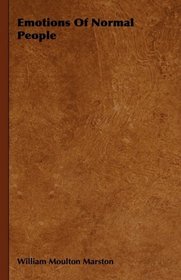Search -
Emotions Of Normal People
Emotions Of Normal People
Author:
Emotions of Normal People By WILLIAM MOULTON MARSTON. Originally published in 1928. Contents include: CHAPTER I NORMALCY AND EMOTION i You are not a Normal Person when Afraid, En raged, Deceptive Normal Emotions are Biologically Efficient Emotions-Present Emotion Names are Literary Terms, Scientifically Meaningless In what Terms can Normal Emoti... more »
Author:
Emotions of Normal People By WILLIAM MOULTON MARSTON. Originally published in 1928. Contents include: CHAPTER I NORMALCY AND EMOTION i You are not a Normal Person when Afraid, En raged, Deceptive Normal Emotions are Biologically Efficient Emotions-Present Emotion Names are Literary Terms, Scientifically Meaningless In what Terms can Normal Emoti... more »
ISBN-13: 9781443720724
ISBN-10: 1443720720
Publication Date: 11/4/2008
Pages: 440
Rating: ?
ISBN-10: 1443720720
Publication Date: 11/4/2008
Pages: 440
Rating: ?
0 stars, based on 0 rating
Publisher: Cooper Press
Book Type: Hardcover
Other Versions: Paperback
Members Wishing: 2
Reviews: Amazon | Write a Review
Book Type: Hardcover
Other Versions: Paperback
Members Wishing: 2
Reviews: Amazon | Write a Review
Genres:




